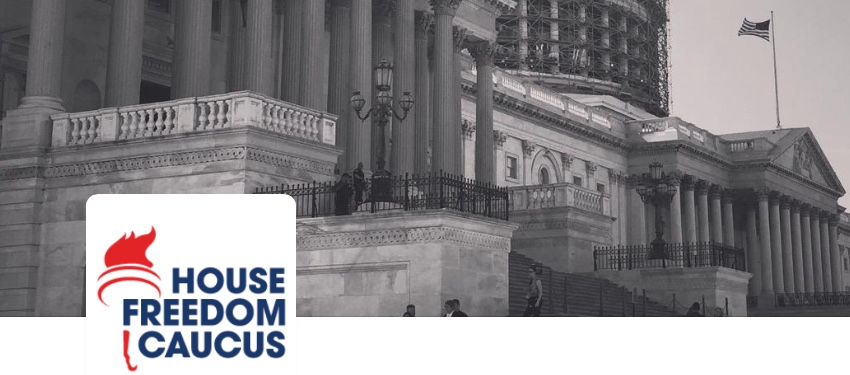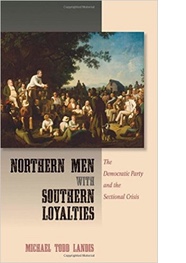The Alarming Parallels this Historian Sees Between What’s Going on in Congress Today and the Antebellum Congresses He Studies

In 2015, about forty extreme anti-government conservatives led by Jim Jordan (R-OH) in the United States Congress coalesced into the “Freedom Caucus,” with the expressed purpose of obstructing federal legislation and achieving a government “shut-down.” Despite its relatively small membership, the group has been impressively vocal and active, causing dramatic rifts in the Republican Party and forcing the Speaker of the House, John Boehner (R-OH), to step down. As the fight over the next Speaker looms, as well as the next Congressional session, members of the Freedom Caucus expect to play a deciding factor.
 Despite what media pundits and
talking-heads may say, and despite Americans’ clear displeasure
with Congressional inactivity (a recent Gallup poll puts public
approval of the legislative branch at an embarrassing
14 percent), federal obstructionism is nothing new. Extreme
conservatives have long aimed to gum-up governmental works,
decentralize authority, and return power to the states and local
elites. The fight dates back to the US Constitution itself, a
document vehemently opposed by “Anti-Federalists” suspicious of
centralized power and a new, united nation (rather than thirteen
separate states).
Despite what media pundits and
talking-heads may say, and despite Americans’ clear displeasure
with Congressional inactivity (a recent Gallup poll puts public
approval of the legislative branch at an embarrassing
14 percent), federal obstructionism is nothing new. Extreme
conservatives have long aimed to gum-up governmental works,
decentralize authority, and return power to the states and local
elites. The fight dates back to the US Constitution itself, a
document vehemently opposed by “Anti-Federalists” suspicious of
centralized power and a new, united nation (rather than thirteen
separate states).
In the antebellum era, the most energetic obstructionists were Southern enslavers fearful that an empowered government might one day strike at slavery. They opposed all manner of federal action, including seemingly mundane and benign projects such as road and canal building, harbor improvements, river dredging, and western land sales. North Carolina’s Nathaniel Macon declared in 1818, “If Congress can make canals, they can with more propriety emancipate [slaves].”1 And in 1824, John Randolph of Virginia announced in the House, “If Congress possess the power to do what is proposed in this [internal improvements] bill, they may emancipate every slave in the United States.”2 For these men, any government action whatsoever was unacceptable, as it would surely lead to the destruction of their “peculiar institution.”
As the “Cotton Kingdom” grew in size and power throughout the 1820-40s, so did the aggressiveness of conservative obstructionists. By 1849, they were ready to make a stand and achieve an authentic government “shut-down.” In that year, the nation grappled with the potential spread of slavery into the western territories forcibly taken from Mexico. The invasion of Mexico in 1846 had been an unabashed land grab by Southern enslavers led by Democratic President James Polk of Tennessee. More land for more slaves for more cotton. By the 1840s, however, a highly motivated and effective anti-slavery movement had risen in the free states, and many Northerners were no longer willing to follow the dictates of the Southern grandees who had controlled the federal government for decades.
In the 1848 elections, Northern Democrats had bolted their party to join with disillusioned Whigs and anti-slavery activists in a new Free Soil Party, which opposed the expansion of slavery (“Free Soil, Free Labor, Free Men”). Though they did not win the presidency, Free Soilers won impressive Congressional and state victories. When those freshly-elected anti-slavery politicos arrived in Washington, DC for the start of the new 31st Congress (about 13 of 230 in the House and 2 of 52 in the Senate), they were in no mood to cater to pro-slavery demands. Likewise, pro-slavery radicals had no intention of compromising or negotiating with their new Congressional colleagues. The strategy of the radicals was simple: prevent the House from organizing so that no discussion or (God forbid) any action on slavery could occur. Such a plan put the radicals in conflict with moderate conservatives who saw federal power as the best way to spread and protect slavery; moderates wanted to control Congress, not shut it down.
Since the Senate had no real organizational rules, radicals made their stand in the House, which first met on December 3, 1849. As soon as the gavel brought the body to order in the semi-circular, white-columned hall, debates flared over House organization and slavery. “The most exciting spectacle I have ever witnessed,” Pennsylvania editor John Forney wrote with anticipation. “The subject is the slave question; and there is now danger of a sectional [crisis] of the very worst character.”3 Conservative moderates, operating primarily in the Democratic Party, nominated enslaver Howell Cobb of Georgia for Speaker, while Whigs, who preferred to avoid the issue of slavery entirely, nominated Robert Winthrop of Massachusetts. There was almost no way that Southerners would accept a New Englander in the Speaker’s chair, and there was even less likelihood of Southern Democrats accepting a Northern Whig. Free Soilers rejected both candidates, but lacked the votes to mount an effective challenge. On the first ballot, 103 voted for Cobb, 96 for Winthrop, and 8 for the Free Soiler David Wilmot of Pennsylvania.4 No clear majority, thus deadlock. And without a Speaker, the House could not organize.
Time was on the side of Southern extremists. Federal inaction would lend credibility to the cause of disunion, which they had championed for years. If Southerners could obstruct Congress and trigger a national crisis, Americans might turn against the federal government. The game, of course, was evident to Northern observers. Representative Thomas Harris of Illinois vented to a friend: If the South wanted to end the stalemate, he fumed, why did they not vote for a Northern candidate? “The reason was he was a Northern Man. Why did [Southerners] not vote for Winthrop five weeks ago & end the struggle for Speaker? The reason was he was a northern man.” “It cannot be disguised,” he continued, “that . . . there is practiced an unyielding proscription of northern men. No northern man can ever be endured by them, unless he goes as far as they do in abusing the whole north.”5
As the deadlock dragged on for weeks, the sense of national calamity deepened. Radicals seemed to be achieving their goals, and they enflamed the crisis further by intensifying their disunionist rhetoric. On December 13, obstructionist leader Robert Toombs of Georgia declared that anti-slavery Northerners were to blame for the stalemate, and encouraged the South to stand firm against would-be Northern tyranny. The South would not, and should not, accept a Northern Speaker. “The interests of my section of the Union,” Toombs explained, playing the victim, “are in danger, and I am therefore unwilling to surrender the great power of the Speaker’s chair without obtaining security for the future.” As he spoke, though, Toombs dropped the façade of victim and revealed his true goals of obstruction and disunion. “We have just listened to strong appeals upon the necessity of organizing the House. I confess I do not feel that necessity. From the best lights before me, I cannot see that my constituents have anything to hope from your legislation, but everything to fear . . . I do not, then, hesitate to avow before this House and the country . . . that if by your legislation you seek to drive us from the territories . . . and to abolish slavery in this District . . . I am for disunion.” Restrictions of any kind on slavery, he concluded, would be “the consummation of all evil.”6
The declaration and the exchange that ensued threw the chamber into chaos. Now, instead of debating the Speakership and the spread of slavery, members were forced to confront imminent disunion. “Every thing here is in Confusion . . . The extreme Southern men are becoming perfectly reckless,” Senator James Shields of Illinois observed.7 Meanwhile, no Congressional business occurred. Even though Winthrop out-polled Cobb on the very next ballot after Toomb’s threat (Winthrop 59, Cobb 408), Southern obstructionism was working – the federal government appeared inept and Congress remained crippled. It seemed as though the nation teetered on the precipice.
In the end, moderate conservatives were able to orchestrate a vote to change the House rules to elect Cobb on a plurality (Cobb 102, Winthrop 99). On December 22, after sixty-three ballots, the House finally had a Speaker and could organize. In turn, the Senate got to work and the federal government limped into action on the pressing issues of the day (namely escaped slaves, slavery in DC, slavery in the territories, Texas debt, and the Texas border). The result, by the end of the summer of 1850, would come to be called the “Compromise of 1850,” although Southerners achieved almost all their demands.
Disunion, of course, did not occur in 1849, but it did in 1860-61. The Civil War may have put to rest issues of states rights and federal power, but it did not end the obstructionist tactics of the antebellum era. Those exact tactics, perfected in the 1850s and implemented many times since (most famously against school desegregation in the 1950s and healthcare reform in the 1990s), are being employed today by the Freedom Caucus. Regardless of what the Freedom Caucus will do in the 114th Congress, periodic anti-government obstructionism will persist.
__________
1 Howe, What Hath God Wrought, 221.
2 Howe, What Hath God Wrought, 222.
3 John Forney to James Buchanan, Dec. 13, 1849, James Buchanan Papers, Historical Society of Pennsylvania.
4 Congressinal Globe, 31st Congress, 1st Session, 2.
5 Thomas Harris to Charles Lanphier, Jan. 12, 1850, Charles Lanphier Papers, Lincoln Presidential Library.
6 Congressinal Globe, 31st Congress, 1st Session, 27-28 (quoted).
7 James Shields to James Buchanan, Dec. 8, 1849, James Buchanan Papers, Historical Society of Pennsylvania.
8 Congressinal Globe, 31st Congress, 1st Session, 31.